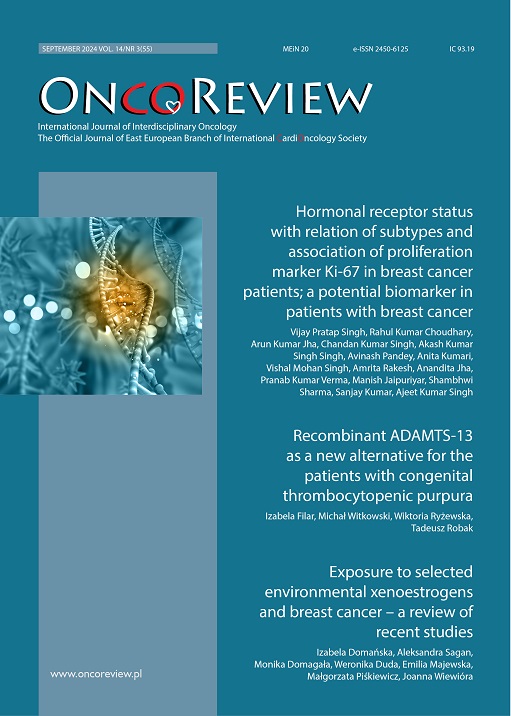Hormonal receptor status with relation of subtypes and association of proliferation marker Ki-67 in breast cancer patients; a potential biomarker in patients with breast cancer Original article
Main Article Content
Abstract
Background: Hormone receptor status is an important prognostic and therapeutic tool in breast cancer. The present study aimed to determine the comprehensive analysis of hormone receptor status and Ki-67 in breast cancer patients at a tertiary cancer centre.
Methods: The relationship of subtypes ER+PR+, ER+PR-, HER2 subtype (Luminal HER2; ER+PR+HER2+), and HER2 enriched (ER-PR-HER2+) status with multiple variables were evaluated. The expression of Ki-67 was strongly associated with cancer proliferation and is a known indicator of prognosis and outcome. The study was carried out in Savera Cancer and Multispeciality Hospital, Patna, India.
Result: This study includes a total of (n=979) breast cancer cases diagnosed at our centre, out of which (n=335; 34.22%) cases went through hormonal investigation. Luminal A (31.05%) subtype was the most prevalent, followed by triple negative (20.16%), luminal B (8.4%), and HER2-positive (20.05%). Majority of the tumours were located on right side (n=186; 55.52%), on the left (n=131; 39.1%) and bilateral (n=18; 5.37%) not significant (P <0.0003). As per ECOG performance status criteria 148 (44.17%) patients were on scale 3, 89 (26.56%) – on scale 2 and 24, 37, and 37 – on scale 0, 1 and 4 respectively statistical value (P=0.325). Remarkable finding in this study Ki-67 level was increased in >50% cases of TNBCs which was significant (P=0.05). As per AJCC staging criteria (n=205; 61.19%) cases were in stage III (locally advanced breast cancer). The value was significant (P=0.05). A total of 236 (72.39%) patients are alive with life expectancy of >24 months.
Conclusion: In conclusion, this retrospective study demonstrated a high prevalence rate of triple negative breast cancer at our centre. Majority of cases were of TNBC subtypes. Another remarkable finding of this study was, in majority of triple negative cases Ki-67 level was >50%. Elevated level of Ki-67 indicated the aggressiveness of tumor types.
Downloads
Metrics
Article Details

This work is licensed under a Creative Commons Attribution-NonCommercial 4.0 International License.
Copyright: © Medical Education sp. z o.o. This is an Open Access article distributed under the terms of the Attribution-NonCommercial 4.0 International (CC BY-NC 4.0). License (https://creativecommons.org/licenses/by-nc/4.0/), allowing third parties to copy and redistribute the material in any medium or format and to remix, transform, and build upon the material, provided the original work is properly cited and states its license.
Address reprint requests to: Medical Education, Marcin Kuźma (marcin.kuzma@mededu.pl)
References
2. Ferlay J, Soerjomataram I, Dikshit R et al. Cancer incidence and mortality worldwide: sources, methods and major patterns in GLOBOCAN 2012. Int J Cancer. 2015; 136(5): E359-86. http://doi.org/10.1002/ijc.29210.
3. Brierley JD, Gospodarowicz MK, Wittekind C. TNM classification of malignant tumors. John Wiley & Sons, 2016.
4. Cao SS, Lu CT. Recent perspectives of breast cancer prognosis and predictive factors Oncol Lett. 2016; 12: 3674-8.
5. Giuliano AE, Connolly JL, Edge SB et al. Breast Cancer-Major changes in the American Joint Committee on Cancer eighth edition cancer staging manual. CA Cancer J Clin. 2017; 67(4): 290-303. http://doi.org/10.3322/caac.21393.
6. Sung H, Ferlay J, Siegel RL et al. Global cancer statistics 2020: GLOBOCAN estimates of incidence and mortality worldwide for 36 cancers in 185 countries. CA Cancer J Clin 2021; 71: 209-49.
7. Ferlay J, Ervik M, Lam F et al. Global cancer observatory: Cancer today. Lyon, France: International Agency for Research on Cancer; 2020.
8. DeSantis C, Siegel R, Bandi P et al. Breast cancer statistics, 2011. CA Cancer J Clin. 2011; 61(6): 409-18. http://doi.org/10.3322/caac.20134.
9. Schlatter RP, Matte U, Polanczyk CA et al. Costs of genetic testing: Supporting Brazilian Public Policies for the incorporating of molecular diagnostic technologies. Genet Mol Biol. 2015; 38(3): 332-7. http://doi.org/10.1590/S1415-475738320140204.
10. Torre LA, Siegel RL, Ward EM et al. Global cancer incidence and mortality rates and trends – an update. Cancer Epidemiol Biomark Prev. 2016; 25(1): 16–27. https://doi.org/10.1158/1055-9965.
11. Boyle P. Triple-negative breast cancer: Epidemiological considerations and recommendations. Ann Oncol. 2012; 23(suppl 6): vi7-12.
12. Brewster AM, Chavez-MacGregor M, Brown P. Epidemiology, biology, and treatment of triple-negative breast cancer in women of African ancestry. Lancet Oncol. 2014; 15: e625-34.
13. Abdou Y, Gupta M, Asaoka M et al. Left sided breast cancer is associated with aggressive biology and worse outcomes than right sided breast cancer. Sci Rep. 2022; 12(1): 13377. http://doi.org/10.1038/s41598-022-16749-4.
14. Alkabban FM, Ferguson T. Breast Cancer. In: StatPearls. StatPearls Publishing, Treasure Island (FL) 2023.
15. Anders CK, Hsu DS, Broadwater G et al. Young age at diagnosis correlates with worse prognosis and defines a subset of breast cancers with shared patterns of gene expression. J Clin Oncol. 2008; 26: 3324-30.
16. Leong SP, Shen ZZ, Liu TJ et al. Is breast cancer the same disease in Asian and Western countries? World J Surg. 2010; 34: 2308-24.
17. Sandhu GS, Erqou S, Patterson H et al. Prevalence of triple-negative breast cancer in India: Systematic review and meta-analysis. J Glob Oncol. 2016; 2: 412-21.
18. Goldhirsch A, Winer EP, Coates AS et al. Personalizing the treatment of women with early breast cancer: Highlights of the St Gallen International Expert Consensus on the Primary Therapy of Early Breast Cancer 2013. Ann Oncol. 2013; 24: 2206-23.
19. Wang W, Wu J, Zhang P et al. Prognostic and predictive value of Ki-67 in triple-negative breast cancer. Oncotarget. 2016; 7(21): 31079-87. http://doi.org/10.18632/oncotarget.9075.
20. Swaminathan R, Rama R, Shanta V. Lack of active follow-up of cancer patients in Chennai, India: implications for population-based survival estimates. Bull. World Health Organ. 2008; 86: 509-15.

